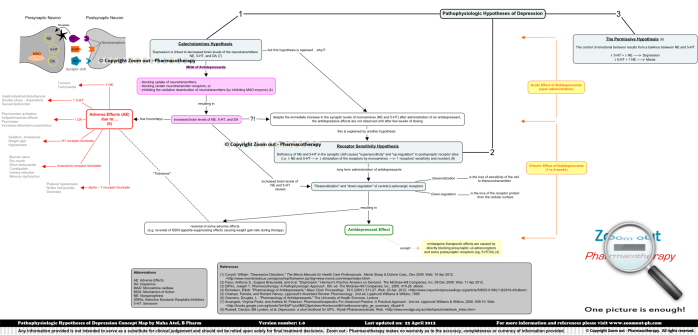Although depression is a disorder of unknown cause, many hypotheses have tried to explain the pathophysiology of depression. Among the most prominent of these hypotheses are those mentioned in the following map of (Phathophysiologic Hypotheses of Depression):

The first one is “Catecholamines Hypothesis” which proposes that depression is linked to decreased brain levels of the neurotransmitters norepinephrine (NE), serotonin (5-HT), and/or dopamine (DA). But it has been observed that the administration of antidepressants causes immediate increase in the synaptic levels of monoamines (NE and 5-HT)producing antidepressants adverse effects, while the antidepressive effects are not observed until after few weeks of dosing. That observation is explained by the second hypothesis which is (Receptor Sensitivity Hypothesis).
According to “Receptor Sensitivity Hypothesis,” the decrease in NE and 5-HT results in low stimulation of the postsynaptic receptors by these monoamines, and consequently increased postsynaptic receptors’ sensitivity and number. That is how long term administration of antidepressants is responsible for decreasing the sensitivity “desensitization” and the number “down-regulation” of central β-adrenergic receptors and finally producing the antidepressant effect.
Concerning the third hypothesis which is called “The Permissive Hypothesis,” the control of emotional behavior results from a balance between NE and 5-HT, i.e. the decrease in both 5-HT and NE causes depression, while the decrease in 5-HT with an increase in NE causes mania.
This map provides you with the basic knowledge to understand the nature of the disease. In the upcoming full map of (Depression), I will link between “Depression pathophysiology” and:
- how antidepressants work (i.e. mechanisms of action) and
- what adverse effects they produce
I hope you gain value from this map, and I look forward to hearing your feedback.
The fact that effective antidepressants increase 5-HT and NE activity led to the development of the monoamine hypothesis: that depression is caused by too little monoaminergic activity. Consistent with this hypothesis, reserpine (which blocks the storage of monoamines in the synaptic vesicles) can produce depressive symptoms in some individuals. Together, it makes sense that depression may be due to a pathological reduction in monoaminergic activity. Mike mentioned how many aspects of depression are consistent with 5-HT and NE dysfunction. Depression is related to changes in sleep and fatigue, eating alterations, etc.—behaviors that are regulated by NE and 5-HT.